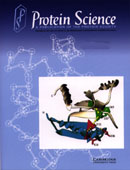Crossref Citations
This article has been cited by the following publications. This list is generated based on data provided by
Crossref.
Okun, Vadim M.
Moser, Rosita
Ronacher, Bernhard
Kenndler, Ernst
and
Blaas, Dieter
2001.
VLDL Receptor Fragments of Different Lengths Bind to Human Rhinovirus HRV2 with Different Stoichiometry.
Journal of Biological Chemistry,
Vol. 276,
Issue. 2,
p.
1057.
Kurniawan, Nyoman D.
Aliabadizadeh, Khosrow
Brereton, Ian M.
Kroon, Paulus A.
and
Smith, Ross
2001.
NMR structure and backbone dynamics of a concatemer of epidermal growth factor homology modules of the human low-density lipoprotein receptor.
Journal of Molecular Biology,
Vol. 311,
Issue. 2,
p.
341.
Reithmayer, Manuela
Reischl, Andrea
Snyers, Luc
and
Blaas, Dieter
2002.
Species-Specific Receptor Recognition by a Minor-Group Human Rhinovirus (HRV): HRV Serotype 1A Distinguishes between the Murine and the Human Low-Density Lipoprotein Receptor.
Journal of Virology,
Vol. 76,
Issue. 14,
p.
6957.
Jansens, Annemieke
van Duijn, Esther
and
Braakman, Ineke
2002.
Coordinated Nonvectorial Folding in a Newly Synthesized Multidomain Protein.
Science,
Vol. 298,
Issue. 5602,
p.
2401.
Jeon, Hyesung
and
Blacklow, Stephen C
2003.
An Intramolecular Spin of the LDL Receptor β Propeller.
Structure,
Vol. 11,
Issue. 2,
p.
133.
Andersen, Olav M
Vorum, Henrik
Honoré, Bent
and
Thøgersen, Hans C
2003.
Ca2+ binding to complement-type repeat domains 5 and 6 from the low-density lipoprotein receptor-related protein.
BMC Biochemistry,
Vol. 4,
Issue. 1,
Machicado, C.
Castillo, S.
Bueno, M.
Pocoví, M.
and
Sancho, J.
2003.
Mutaciones del receptor de LDL que permiten considerar la hipercolesterolemia familiar dentro de las enfermedades del plegamiento de las proteínas.
Clínica e Investigación en Arteriosclerosis,
Vol. 15,
Issue. 2,
p.
59.
Neumann, Emmanuelle
Moser, Rosita
Snyers, Luc
Blaas, Dieter
and
Hewat, Elizabeth A.
2003.
A Cellular Receptor of Human Rhinovirus Type 2, the Very-Low-Density Lipoprotein Receptor, Binds to Two Neighboring Proteins of the Viral Capsid.
Journal of Virology,
Vol. 77,
Issue. 15,
p.
8504.
Li, Ankang
Sadasivam, Murali
and
Ding, Jeak Ling
2003.
Receptor-Ligand Interaction between Vitellogenin Receptor (VtgR) and Vitellogenin (Vtg), Implications on Low Density Lipoprotein Receptor and Apolipoprotein B/E.
Journal of Biological Chemistry,
Vol. 278,
Issue. 5,
p.
2799.
Rudenko, Gabby
and
Deisenhofer, Johann
2003.
The low-density lipoprotein receptor: ligands, debates and lore.
Current Opinion in Structural Biology,
Vol. 13,
Issue. 6,
p.
683.
Boswell, Emma J.
Jeon, Hyesung
Blacklow, Stephen C.
and
Downing, A. Kristina
2004.
Global Defects in the Expression and Function of the Low Density Lipoprotein Receptor (LDLR) Associated with Two Familial Hypercholesterolemia Mutations Resulting in Misfolding of the LDLR Epidermal Growth Factor-AB Pair.
Journal of Biological Chemistry,
Vol. 279,
Issue. 29,
p.
30611.
Beglova, Natalia
Jeon, Hyesung
Fisher, Carl
and
Blacklow, Stephen C.
2004.
Cooperation between Fixed and Low pH-Inducible Interfaces Controls Lipoprotein Release by the LDL Receptor.
Molecular Cell,
Vol. 16,
Issue. 2,
p.
281.
Beglova, N.
Jeon, H.
Fisher, C.
and
Blacklow, S.C.
2004.
Structural features of the low-density lipoprotein receptor facilitating ligand binding and release.
Biochemical Society Transactions,
Vol. 32,
Issue. 5,
p.
721.
Jeon, Hyesung
and
Blacklow, Stephen C.
2005.
STRUCTURE AND PHYSIOLOGIC FUNCTION OF THE LOW-DENSITY LIPOPROTEIN RECEPTOR.
Annual Review of Biochemistry,
Vol. 74,
Issue. 1,
p.
535.
Beglova, Natalia
and
Blacklow, Stephen C.
2005.
The LDL receptor: how acid pulls the trigger.
Trends in Biochemical Sciences,
Vol. 30,
Issue. 6,
p.
309.
Jensen, Gitte A.
Andersen, Olav M.
Bonvin, Alexandre M.J.J.
Bjerrum-Bohr, Ida
Etzerodt, Michael
Thøgersen, Hans C.
O'Shea, Charlotte
Poulsen, Flemming M.
and
Kragelund, Birthe B.
2006.
Binding Site Structure of One LRP–RAP Complex:Implications for a Common Ligand–Receptor Binding Motif.
Journal of Molecular Biology,
Vol. 362,
Issue. 4,
p.
700.
Nguyen, Anh T.
Hirama, Tomoko
Chauhan, Vinita
MacKenzie, Roger
and
Milne, Ross
2006.
Binding characteristics of a panel of monoclonal antibodies against the ligand binding domain of the human LDLr.
Journal of Lipid Research,
Vol. 47,
Issue. 7,
p.
1399.
Contreras-Alcantara, Susana
Godby, Jesse A.
and
Delos, Sue E.
2006.
The Single Ligand-binding Repeat of Tva, a Low Density Lipoprotein Receptor-related Protein, Contains Two Ligand-binding Surfaces.
Journal of Biological Chemistry,
Vol. 281,
Issue. 32,
p.
22827.
Lillis, Anna P.
Van Duyn, Lauren B.
Murphy-Ullrich, Joanne E.
and
Strickland, Dudley K.
2008.
LDL Receptor-Related Protein 1: Unique Tissue-Specific Functions Revealed by Selective Gene Knockout Studies.
Physiological Reviews,
Vol. 88,
Issue. 3,
p.
887.
Roosendaal, Sigrid D.
Kerver, Jana
Schipper, Maria
Rodenburg, Kees W.
and
Van der Horst, Dick J.
2008.
The complex of the insect LDL receptor homolog, lipophorin receptor, LpR, and its lipoprotein ligand does not dissociate under endosomal conditions.
The FEBS Journal,
Vol. 275,
Issue. 8,
p.
1751.

